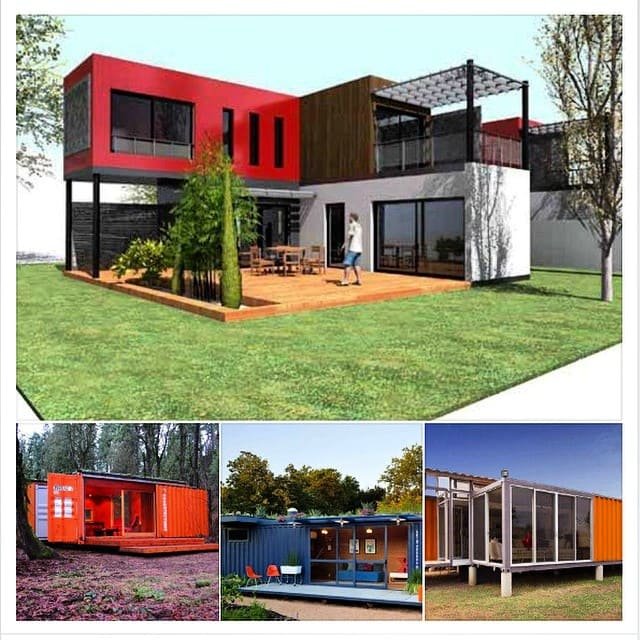If you want to build a modern house but want a factory to do at least part of the work for you, you’re probably interested in modular and prefabricated homes. These two terms are often used interchangeably when talking about home construction, but they are not identical.
What are the differences between modular homes and prefabricated homes?
“Modular” is a more specific term than “prefabricated”.
Let’s look at the differences between the two so you can make the right choice for your needs. The best way to approach this topic is by defining the term “prefabricated homes.” The reason is that prefabricated is actually a category of construction methods rather than a specific construction method.
In fact, it’s an umbrella term that includes modular homes as well as those built using other methods such as panel construction and steel structures. If any part of the house was manufactured in a factory beforehand and then transported to the site, that house is defined as “prefabricated.”
Types of prefabricated homes
Prefabricated homes, in general, can be divided into three main categories. Although your main interest is probably in modular homes, it’s also worth taking a brief look at the other two.
Modular prefabricated homes
Modular homes are built with pre-assembled modules, as the name suggests. These modules can be visualized as complete rooms that are stacked together like building blocks. If you think of assembling Lego bricks, where each brick represents a separate module, you’ll have the right idea in mind.
The most obvious example of modular design is homes built with shipping containers. This construction method offers tremendous adaptability. A modular home can consist of a single unit, or they can be stacked together in any orientation you choose. Rooms can be added or removed at any time.
Prefabricated homes with panels or panelized construction
With this type of prefabricated design, the foundation and floor are laid first. Once they are in place, fixtures can be added or steps can be postponed. Then, each finished wall is lowered and installed. If there is a second floor, it will be installed next, followed by the walls of the second floor.
You will see panelized construction more often than modular construction when it comes to building offices and other commercial structures. The reason is that this type of construction allows for greater openness within the buildings. Another advantage is that it is more cost-effective to ship wall panels than to ship complete modular units.
Mobile prefabricated homes
A third option for prefabricated homes is what is simply known as a “mobile prefabricated home” or “mobile home.” This type of home is built entirely in a factory. Wheels are added so it can be transported to the site, which usually includes a concrete foundation. Once the home is situated, the wheels may or may not be removed.
In the past (before 1976), the general term for this style was “trailer” or “mobile home,” but modern prefabricated homes have stringent building guidelines that surpass the common pitfalls of mobile trailers. Common size terms are single-wide, double-wide, and triple-wide.
When the wheels are not removed, side skirts are installed around the base of the home. This is intended to hide the wheels, but the appearance is still so often associated with prefabricated homes that the nature of the building is still quite obvious. Note that this type of home typically has a steel structure. Wood structures used to be common in the past but are now less frequent.
Prefabricated vs. Modular: Which is better?
Now you understand that you have three options for prefabricated homes. But which one should you go with? Should you buy a prefabricated home? Or would it be better to opt for a panelized home? Or are modular homes better? There is no single “better” option as individual needs may vary. You will have to weigh the pros and cons of each.
Here are some things to consider:
- Building codes: If you want to avoid dealing with building codes, a prefabricated home may help you overcome them, although you still need to ensure it meets the standards set by your city and place of residence.
- Stability and longevity: A detractor of prefabricated homes is that they tend to develop more issues than other styles of prefabricated homes. The most resilient option is modular design. In fact, it can be a superior option to having a home built entirely on-site in a traditional manner. The Federal Emergency Management Agency (FEMA), responsible for responding to hurricanes, earthquakes, floods, and other natural disasters, based in Washington D.C., United States, reports, “In general, relatively minimal structural damage has been observed in modular housing. The combination of module-to-module construction seems to have provided an inherently rigid system that performed much better than conventional residential framing.” Why is this the case? It has a lot to do with the greater consistency of factory construction. There are fewer variables that can negatively affect the outcome. Deficiencies in terms of labor and materials can lead to structural weaknesses in on-site construction.
- Value: Interestingly, prefabricated homes are not classified as real estate. Instead, they are considered personal property similar to vehicles. As such, they depreciate. This is not always true for other types of prefabricated homes.
- Style and appearance: You may be surprised by the freedom you have in this area, especially if you opt for modular construction. You can embrace the look of a “shipping container” if you wish, but you can also disguise modular construction to make it appear nearly identical to traditionally built architecture. Of course, our favorite style is mid-century modern metal homes, but everyone has their preference.
Final advice
I hope this article is helpful and that you now have a clearer understanding of the differences between modular and prefabricated homes. Whether you choose modular construction or not, if you follow the prefabricated path for your next home, you’ve made an amazing choice. You’ll save time, hassle, and money, and you may end up with a home that withstands wear, weather conditions, and the test of time better.




